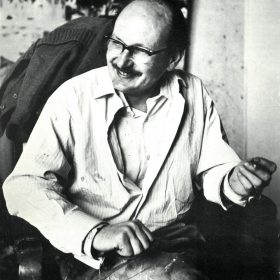signed lower right
EXHIBITED:
Scottish Society of Artists; Robert Henderson Blyth Retrospective Exhibition, The Scottish Gallery, 1987, cat.59
Green Landscape reflects Blyth’s mature style, where the natural world is not meticulously rendered but rather used as a structural and emotional starting point. His compositions often use the landscape as an emotional vehicle, with forms pared down and atmosphere heightened to evoke mood and memory rather than topographic accuracy.

Robert Henderson Blyth was a distinctive voice in post-war Scottish painting, known for his expressive treatment of the landscape and his subtle shift towards abstraction. Born in Glasgow, Blyth studied at the Glasgow School of Art from 1934-1939. A painter of considerable sensitivity, he served during the Second World War, an experience that left a lasting impression on the emotional undercurrents of his work.
After The War, Blyth quickly gained recognition, receiving the Guthrie Award from the Royal Scottish Academy in 1945. He began teaching at Edinburgh College of Art from 1946 and later became artist-in-residence at Hospitalfield House, Arbroath a centre known for its vital role in developing post-war Scottish modernism. In 1954, Blyth moved north to take up a post at Gray’s School of Art in Aberdeen, becoming Head of Drawing in 1960, a role he held until his untimely death in 1970.